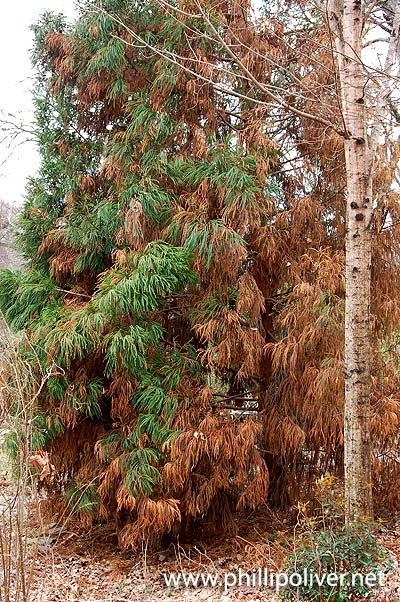Swapping Huckleberries
Himalayan Honeysuckle ( Vaccinium glauco album) Himalayan Honeysuckle ( Vaccinium glauco album) has been an attractive feature along our north-facing foundation since I planted it in 2016. You will have to take my word for it since I cannot locate a photo although I know one exists somewhere in the realm of the Internet or floating on a cloud somewhere. I did locate a photo of how it looked when it was first planted - It took a few years to fill out but it did so nicely to an attractive mound about 2 feet high by 3 feet wide. Last year, it started to look bad. I cut it back but it had not improved and this is how it looked a few weeks ago - I decided to rip it out and plant another huckleberry - this time Vaccinium ovatum , more commonly known as the "Evergreen Huckleberry". This is a plant that I've wanted for ages and kept putting off getting one because I could not find a good place for it. By most accounts, this is an amazing plant, a native one and excellent for




Sound advice for those in your corner of the globe. I hope you can deal with the problem effectively now, your hydrangeas look magnificent in previous posts.
ReplyDeleteThis is good to know. I hope not to see such a thing here. I have lots of hydrangeas.
ReplyDeletePhillip, that is a shame that you may have to destroy them. But at least you know and have been able to warn others.
ReplyDeleteHydrangeas bring such great color & texture to a garden.
I agree with Lisa...I have not seen this problem in Illinois (as of yet!!) and hope I will not. I have added many hydrangeas to my property over the past few years and would hate to lose them. Good luck with yours!
ReplyDeleteP.S. You have an interesting blog - I am new to blogging and realize I have much to learn... :)
Who knew?! I wonder if this is what killed my limelight. I had assumed it was some sort of fungus/rot.
ReplyDeleteYikes! I don't grow the hydrangeas that you do...and boy are yours beauties~but I'll pass this info onto friends. Thanks Phillip, gail
ReplyDeleteFortunately, this hasn't hit hydrangeas in MI yet, but it's good to be aware of. Yet another reason I love reading blogs from around the country! :)
ReplyDeleteOh, man, that is the pits. Glad you figured out what it was. I'll keep watch on my hydrangeas too.~~Dee
ReplyDeletethanks for comments
ReplyDeletehttp://www.rdrop.com/~paul/hulse.html
this is the site that i found that explained how to do the rose cuttings - like i said it's the wrong time of the year - the rose has no leaves, but i still hope some of them make it. Good Luck!
Philip, thanks for the tips on the Hydrangeas.
ReplyDeleteBTW, your hydrangeas look great
Aanee
Irish Florist
I just discovered this borer in my own garden. I am new at gardening, but planted Hydrangea's this spring - one of my favorites. My husband & I purchased a hundred yr old farmhouse with an acre of property, so there was already a well established Hydrangea there, and now they both have what appears to be the "black twig borer" you described. Were you able to get rid of it? Do you have anymore tips? Thank you!
ReplyDeleteAm having a significant issue with these this year 2021 in Atlanta, GA on Blue Nikkos. Seem to also be targeting stems on an adjacent bay laurel. Seems to target both old growth portion of stem and new growth indiscriminantly - is there ANYTHING that could be added to the soil to eliminate them? Have yet to actually see one on the 'outside' of the stem or even see any larvae when I cut the stems off and cut them open to inspect - just very small black bugs themselves. I am afraid i am going to completely lose a 10 year old hydrangea. Seems like the more stems I cut, the more they attack other stems at this point.
ReplyDelete